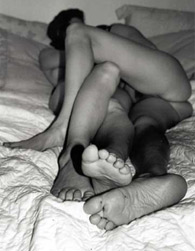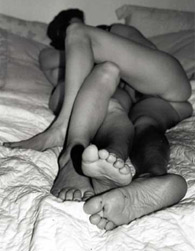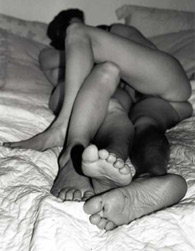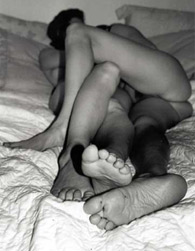If you ask most lesbians what they believe is the number one problem of long-term lesbian couples, they would say, "Lesbian bed death." The notorious drop off in sexual activity, whether real or simply feared, has become the subject of jokes in the lesbian community, but it has also led lesbians to worry about when the endemic lesbian syndrome will strike their relationships. Some clients come in diagnosing themselves as victims of lesbian bed death. Some want their therapists to reassure them that long-term lesbian couples really can have great sex. I have heard lesbian therapists and clients theorise that bed death strikes lesbians because the patriarchy intrudes on woman-to-woman sex and makes women too self-conscious to sustain sexual relationships. Others have suggested that there's nothing wrong with lesbians not having sex, or having it infrequently; maybe this is the nature of women's sexuality, and we just need to get used to it, change our expectations.

The major research study that has fueled the lesbian bed death myth was published in 1983, in a book called American Couples by Philip Blumstein and Pepper Schwartz. Their empirical research reported that lesbian couples had less sex than any other couple -- heterosexual married, heterosexual co-habitating or gay male. Since the 1980s, many books and articles by lesbian practitioners have been written about lesbian sexuality by well known clinicians such as Marny Hall, JoAnn Loulan and Marge Nichols that dealt with inhibited sexual desire, lack of sexual initiation and low sexual self-esteem.
Despite the above-mentioned data and seemingly confirming clinical experience that shows that lesbian bed death is, indeed, a widespread phenomenon, I don't believe it exists as a clinical entity. In fact, I think it's time we exposed lesbian bed death as being a fraud. Lesbian couples are not any different from gay or heterosexual couples when it comes to experiencing the inevitable shifts in sexual passion in longterm relationships. Read heterosexual sex therapist David Schnarch's work if you don't believe heterosexual couples grapple with similar issues. In the 1995 Advocate Survey of Lesbian Sexuality and Relationships, results showed that lesbian women had more enjoyable sex than most American women. Somehow, this data has not received the same attention as the 1983 report from Blumstein and Schwartz. Why is that? Are we too quick to ignore data that flies in the face of a pathologised view of lesbian sexuality?
Many of my lesbian colleagues fight me on this one, believing that lesbian couples have it more or have it worse or have special reasons for having it more or worse. My view is that my lesbian clients who come in complaining of reduced sexual interaction are experiencing real life. I continue to see the same pattern in these clients: not unlike their heterosexual brothers and sisters, and gay brothers, the women met, fell in love and created a life together. Their work and family lives developed and demanded attention and energy, sometimes at the cost of quality intimate time together. They experienced the blissful merging that only new love (and lust) offers, the honeymoon receded, revealing sexual differences and incompatibilities and life's demands made themselves known. Simply put, I believe there is no such thing as lesbian bed death, unless we also want to coin the terms "gay bed death" and "straight bed death." This is not a lesbian phenomenon. It's time to move on to a more realistic and less negative view of lesbian sex.
Debunking the Term
Lesbian bed death is a powerful and destructive term; its development is based on misinterpretations of research, simplistic understandings about gender differences and internalised cultural prejudices about women and lesbians. The term is pejorative and pathologising, and woe-fully inadequate in communicating the complexity of sexual relating in lesbian couples. Targeting lesbian women's sexuality in this way is yet another example of misogyny masquerading as clinical objectivity where male definitions of sexuality are used as the hallmarks of sexual health.

The problem may be that we lesbians are allowing our internalised homophobia and sex phobia to govern the way we view our sexual lives. Is autonomous lesbian sex so threatening to the patriarchy that we'd rather deaden ourselves, or pretend to be sexless in order to be less of a target? Ironic how often our gay brothers carry the promiscuous torch as we carry the sexless one, both extremes of male and female sexual stereotypes, the carrying of which represents an identification with the aggressor. The underlying cultural message is "gay and lesbian relationships are sick, they don't have the sexual balance of heterosexual relationships" -- a heterosexist view that complementarily is necessary for relationship stability.
I suggest we debunk the term. One woman in a recent workshop plead-ed for an alternate, but still simple, term for it. I asked, "What's 'it'?" She said, "The unavoidable changes in sex in long-term relationships." Exactly. There is danger in relying on simple terms to represent complex processes.
What Sex Research Really Shows
A careful reading of Blumstein and Schwartz's study as well as other sex research provides little evidence that lesbian sexuality is less active or less fulfilling than gay or heterosexual sex. A crucial aspect here is how questions are asked and what the answers really mean. The now-infamous finding of Blumstein and Schwartz that lesbian couples have less sex is based on answers to one question: "About how often during the last year have you and your partner had sexual relations?"
Asking "how many times" to lesbian couples is problematic because sexuality between women is not defined by discreet genital acts the way sex often is when a penis is involved. This question is an example of male-defined measurements of sex that misrepresent the subjective experiences of women. A few years after American Couples was published, lesbian feminist scholar Marilyn Frye questioned the validity of sex research such as Blumstein and Schwartz's that compares numbers of times that couples "have sex." She stated that "what 85 percent of long-term, married couples do more than once a month takes on average 8 minutes to do... what we (lesbians) do that, on average, we do considerably less frequently, takes, on the average, considerably more than 8 minutes to do. Maybe about 30 minutes at least."
Fyre makes a point that is supported by well-known sex researchers Virginia Masters and William Johnson's 1979 research in which lesbian, gay and heterosexual couples' sexual behaviour were compared. They found that heterosexual couples were more performance-oriented and preoccupied with orgasmic attainment. Lesbian couples took more time having sex, with sexual interaction beginning with whole-body contact and proceeding with kissing, hugging, touching and holding before breast or genital contact was made. In heterosexual couples, "rarely more than 30 seconds to a minute were spent holding close or caressing the total body area before the breasts or genitals were directly stimulated."
It is safe to say that if sex research questions focused on longevity instead of the number of sexual acts, lesbians would be the winners. Lesbians also are "the winners" in other respects. They are found to be more sexually assertive, sexually arousable, verbally and nonverbally communicative about sexual needs, desires, pleasures and distractions, and more satisfied with the quality of their sexual lives than are heterosexual women. This research has been consistent from the 1979 landmark study, Homosexuality in Perspective by Virginia Masters and William Jobmon, to a 1983 article in the Journal of Sex Research, "Arousability and Sexual Satisfaction in Lesbian and Heterosexual Women," by E.M. Coleman, P.W. Hoon and E.F. Hoon. These findings were also consistent to the chapter "Sexual Fulfillment of Heterosexual, Bisexual and Lesbian Women," by L.C. Bressler and A.D. Lavender in the 1986 book Historkal, Literary and Erotic Aspects of Lesbianism and in my own doctoral dissertation research in 1991. Some studies from as far back as the 1953 Kinsey Report found lesbians to be more orgasmic than heterosexual women.

This brief review of sex research reveals that lesbians fare well in comparison studies, as, by the way, they do in studies of psychological adjustment. Instead of comparing lesbians to others and assuming we come up short, we'd be better off non-judgementally understanding lesbian sexual relating and acknowledging the great diversity in sexual desire and activity that exists among lesbian women.
Understanding Lesbian Sexual Relating
Lesbian couples may draw on physical affection, intimacy, friendship and spiritual, emotional or intellectual connections as equal if not more important ways to bond than the maintenance of genital sexuality. A very interesting book from 1993 by lesbian psychologists Esther Rothblum and Kathleen Brehony: Boston Marriages. Romantic but Asexual Relationships Among Lesbians provides various examples of committed, non-genital lesbian relationships. I have worked with some gay and heterosexual couples who found the book illuminating. Pepper Schwartz's 1994 book, Peer Marriage, describes heterosexual couples who develop what she calls equal or "peer" partnerships in which genital sex is not a central aspect of the relationship. These two books open up the possibility that sexuality may not be the central organising factor for some lesbian couples, and even for some heterosexual (and gay) couples.
The most common reason given why lesbian couples have less sex is based on a simplistic understanding of gender differences. The argument is that men and women are socialised differently: men are socialised to be active sexual subjects, while women are socialised to be passive sexual objects. So, when two women are in a relationship, it would make sense that neither is all that interested in sex, and/or neither feels comfortable initiating, and therefore their sex life suffers. The empirical research cited above doesn't support this contention -- in fact, lesbian women usually score higher on sexual assertiveness measures than do heterosexual women -- and neither does my clinical experience. I typically see couples where at least one partner likes sex and feels comfortable initiating it. The problem with gender socialisation explanations for lesbian sexuality is not that cultural messages play a major role in shaping (lesbian) women's sexuality, but the generalisation that it effects all lesbians in the same way.
There are certain issues that I watch for when I work with lesbian clients dealing with sexual issues. Realising that couples containing two women face particular challenges that often affect the quality of sexual relating, I am alert to the likelihood that at least one partner experienced some form of sexual abuse or assault prior to the relationship. I find out about the effects of menopause. I might explore the cultural messages about beauty that impact women's sense of body image. I find it useful to examine the neglect or messages of outright discouragement of sexual agency in childhood. And when working with lesbians, it is always crucial to keep in mind the effects of the cultural and internalised homophobia and misogyny that create feelings of sexual shame.

Is there clinical evidence that lesbian couples experience sexual infrequency more or in a worse way than do heterosexual or gay couples? I don't think so. What I have found are two factors that can influence all couples experiencing sexual infrequency. The first is their adherence to monogamy, and the second is their ability to tolerate sexual infrequency for long periods of time.
I don't want to give the impression that I think lesbians are any more monogamous than other couples or are able to tolerate sexual infrequency more than other couples. But I have seen in my practice that many lesbian couples believe that they should, above all else, remain sexually monogamous regardless of changes in sexual satisfaction and sexual needs over time. In some of these couples, one partner may either consensually or in secret find alternative sexual outlets (affairs, sexual fantasy, sex clubs, paid sex, phone or Internet sex). When couples of all sexual orientations have an inflexible monogamy agreement and also experience reduced or nonexistent sexual activity, it can create a bind that fosters tremendous levels of anger, resentment, defensiveness and blame. I often try to diffuse some of these feelings through the use of humour -- for example, I quote writer Jewell Gomez, who said in a recent interview, "If I was lovers with someone and they stopped having sex, they could go no longer than four months without a note from their doctor."
It may be that lesbians only appear to tolerate long periods of sexual infrequency. There may be a connection between women's ability to tolerate sexual problems and the fact that female gender identity is not based on sexual performance, as it is for men. I've worked with many a heterosexual woman in sex therapy who tolerated years of unfulfilling sex because she didn't want to rock the boat or make her husband uncomfortable, or because other things in her life provide passion and satisfaction (i.e. children, family, friends, work, other aspects of the marriage). I often see heterosexual and gay couples sooner after sexual reduction begins (usually within a couple of years) because many men cannot tolerate the reduction it so threatens their core sense of masculinity.
Many lesbian couples I've seen in sex therapy have, on average, tolerated sexual reduction 5 to 10 years before seeking help. For some, the infrequency of sex was less important over time than other shared passions and satisfactions. For others, they waited so long before dealing with the issue because earlier couples therapy had failed to address it. And for many, the whole notion of going for "sex therapy" as members of a doubly stigmatised group (female and lesbian) was so daunting it kept them from getting the assistance they needed earlier on.
Suzanne Iasenza, Ph.D., is Associate Professor of Counseling at John Jay College of Criminal Justice, City University of New York, a psychologist and sex therapist in private practice, and co-editor of the book Lesbians and Psychoanalysis.











 Printable Version
Printable Version













Reader's Comments
Be the first to leave a comment on this page!
Please log in to use this feature.